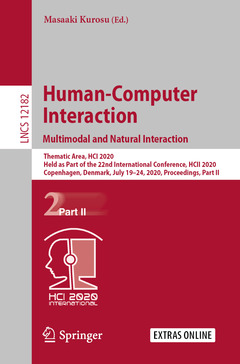Human-Computer Interaction. Multimodal and Natural Interaction, 1st ed. 2020 Thematic Area, HCI 2020, Held as Part of the 22nd International Conference, HCII 2020, Copenhagen, Denmark, July 19–24, 2020, Proceedings, Part II Information Systems and Applications, incl. Internet/Web, and HCI Series
Coordonnateur : Kurosu Masaaki

The three-volume set LNCS 12181, 12182, and 12183 constitutes the refereed proceedings of the Human Computer Interaction thematic area of the 22nd International Conference on Human-Computer Interaction, HCII 2020, which took place in Copenhagen, Denmark, in July 2020.*
A total of 1439 papers and 238 posters have been accepted for publication in the HCII 2020 proceedings from a total of 6326 submissions.
The 145 papers included in these HCI 2020 proceedings were organized in topical sections as follows:
Part I: design theory, methods and practice in HCI; understanding users; usability, user experience and quality; and images, visualization and aesthetics in HCI.
Part II: gesture-based interaction; speech, voice, conversation and emotions; multimodal interaction; and human robot interaction.
Part III: HCI for well-being and Eudaimonia; learning, culture and creativity; human values, ethics, transparency and trust; and HCI in complex environments.
*The conference was held virtually due to the COVID-19 pandemic.
Date de parution : 06-2020
Ouvrage de 735 p.
15.5x23.5 cm
Disponible chez l'éditeur (délai d'approvisionnement : 15 jours).
Prix indicatif 105,49 €
Ajouter au panierMots-clés :
3D; artificial intelligence; data communication systems; gesture recognition; HCI; human-computer interaction; image processing; mobile applications; mobile computing; mobile devices; robotics; robots; semantics; software engineering; software evaluation; speech recognition; telecommunication networks; usability engineering; user experience; user interfaces



